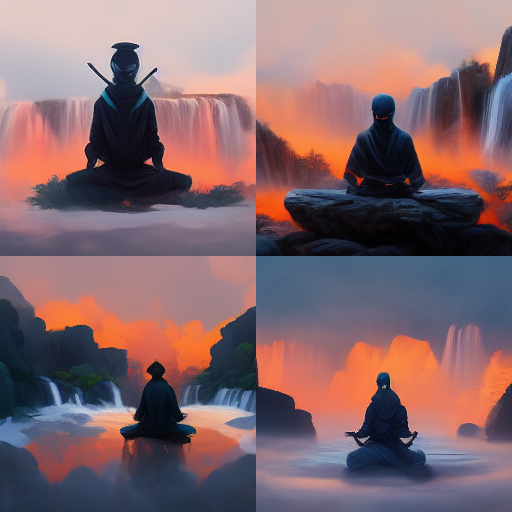Will AI Displace “Traditional” Artists?
What is it about AI that so easily triggers dramatic proclamations? Take, for instance, the “Art is Dead Dude.” This declaration followed after a first place award was given to a contestant who used an AI program called Midjourney to create a surrealistic and impressive work of art. (You can easily find this image on the web, so I won’t link it here.)
I am a big fan of digital art. I am a Photoshop power user (with over 15 years of experience) and over the last decade I have explored and drawn fractals (using Chaotica). With that, I decided to give Midjourney a shot. It was fairly simple, and takes much less time than Photoshop or Chaotica. I used the /imagine command followed by words that described what I wanted to draw; but as I think about it now, it’s more accurate to say “render.” In any event, the program did not disappoint. My “ninja meditating by a waterfall at dawn” produced some pretty remarkable images in less than a minute. Check them out below. This is impressive and even more so considering I would not be able to draw these images by hand. But this is as far as I am willing to go with this. Again, it is impressive, but by no means does this reasonably amount to the death of hand drawn art. This is an overblown declaration.
In many respects, this debate (and others like it) reminds me of professional photographers poopooing amateur photographers that used Photoshop to process their images. And, yes, there were even those who leapt into much more dramatic claims that Photoshop was destroying the profession. If anyone can take awesome pictures, what will professional photographers do? Well, it turns out that professional photographers did and are still doing just fine, the grave concerns, the vast improvements that Adobe has regularly made to the program and the millions of users notwithstanding.
At the end of the day, Midjourney and other AI program like it, such as DALL-E and Stable Diffusion are simply highly sophisticated tools. They are unlikely to displace non-digital artists anytime soon; in fact, just the contrary may turn out to be the case. A “traditional” artist could use this type of program to enhance, layer it with their hand-drawn creation. Another possibility, and one that I view as more plausible, is that we might just be witnessing the emergence of a new genre. At the end of the day, all the various artistic genres can peacefully coexist.
Unfortunately, however, for those of us who are interested in seeing the discourse around AI advance and stabilize beyond the usual hyperbole, the road is long and uncertain. If you wish to explore this further you will find that this issue is also relevant to the unsettled definition of AI, which I have discussed in previous posts, such as AI and the Corrosive Effect of Careless Definition.

***Postscript***
July 31, 2023
In Ninjutsu (ninja martial arts) to say to someone: “wow, you have great technique,” is not a compliment. New and even relatively experienced Ninjutsu practitioners are frequently confused by this statement. Here’s another one to think about: Salvador Dali once said in an interview: “I am a terrible painter.” But how could that be? He’s a genius! Very confusing.
These two statements may seem disconnected and make no sense. But they’re actually not. They express the same principle: true art is a manifest of creativity. In Ninjutsu, the martial artist’s uniqueness is expressed in how he/she moves, recognizes opportunities, adapts and improvises in the chaos that an opponent presents. I understand Dali’s statement as basically saying the same thing in the context of painting. A person can follow directions on how to paint the Mona Lisa. An algorithm can be designed to do the same thing. But the output is not a manifest of true creativity.
Using AI to generate pictures, drawings, stories, and music is interesting and can be useful, but the output is the sum of a technical task. The Copyright Office’s approach is in sync with this view and its position is that the output of a GenAI application does not qualify for copyright protection. But this doesn’t need to be an all or nothing approach. It makes sense to accommodate certain GenAI creations with a low-level type copyright protection status, subject to a secondary copyright protection regime that is reserved for AI generated works, a “secondary copyright,” if you will. (We have something similar for trademarks in the form of the Supplemental Register.) The owner of a secondary copyright enjoys limited rights: shorter duration, narrower remedies for infringement (for example, no monetary damage option) and other characteristics that distinguish it from the traditional copyright. Determining which GenAI creations qualify for secondary copyright will be the subject of a different post.
April 26, 2023
We are ripe for recognizing a new class of artistic capability, perhaps even with layered with virtuosity, in the form of prompts. Simple prompts = simple art. There’s no real compelling public interest in protecting those types of prompts. But complex, sophisticated prompts can generate incredible art. So while the Copyright Office will not (at least for now) grant a copyright to the image, the complex sophisticated prompt, which is essentially the source code for the image, should be registrable subject matter. Perhaps we end up with a marketplace for prompts, like Photoshop plugins.
